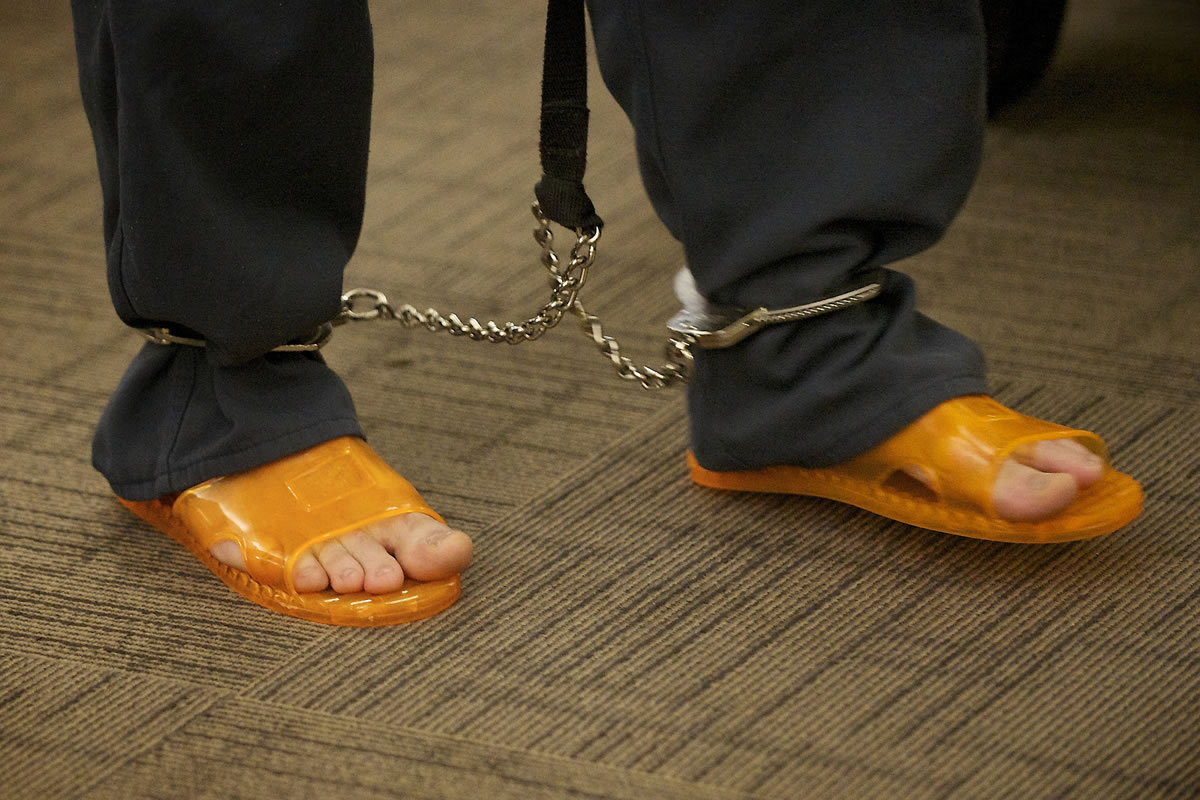Each weekday morning, custody officers escort jail inmates, handcuffed together in a colorful human chain, into the Clark County Courthouse.
They wear jail clothes in hues of orange, blue and green.
While confined in jail, these uniforms are their pajamas, their gym clothes and their “street” clothes. The clothes also convey meaning to custody officers. Certain colors signify accusations of violence or unruly behavior and even a range of emotions, from rebellion to despair.
One of the comforts of freedom is choosing one’s own clothes. Inmates are stripped of that privilege, as well as almost any embellishment, including makeup, jewelry and accessories.
Instead, they enter a color-coded world aimed at maintaining security, order and frugality.
Selecting clothes
Inmates in the Clark County Jail aren’t allowed to choose which color they wear. Booking officers do that. Their color selection signifies whether an inmate has been accused of a violent crime or if he or she is prone to unruly behavior.
“They look at their character, how they’re behaving and what their charge is,” said former jail chief Jackie Webster, who retired in April after 33 years on the job.
Makeup, jewelry and other accessories are confiscated at booking time to protect inmates’ possessions and to prevent fights over items. Inmates also receive a rolled-up sheet, blank and towel, a toothbrush, toothpaste, soap, pencils, paper and envelopes.
Inmates wear their uniforms for all of their activities except showering. They also receive rubber sandals to serve as both “street” shoes and shower sandals.
Jail clothes come in six sizes, from S to XXXL. Inmates who wear a larger than XXXL have to bring their clothes, Webster said.
“Usually inmates wear a two-piece,” Webster said. “It’s easier than a one-piece because they can slip off the shirt when they exercise or sleep.”
Female inmates are asked to keep their tops on when they sleep because the custody officers are men and women, she said.
Extras
In the winter, the courthouse can be cold. Some inmates can be seen wearing cream-colored thermal shirts under their jail shirts and socks in their sandals, but others are limited to the short-sleeve jail uniform.
This isn’t likely a matter of choice. Thermal shirts and socks are a luxury in jail and can only be purchased at the commissary for $7.35 and $1.45, respectively.
Color significance
Orange cotton uniforms, resembling medical scrubs, puts custody officers on notice that an inmate could be violent or unruly. Blue means the inmate has been accused of a misdemeanor or nonviolent felony or has been deemed for any other reason as a low threat.
Quilted green smocks (older ones were blue) indicate an inmate may be suicidal. Inmates who have just been arrested on suspicion of a serious felony, such as murder, may be dressed in a suicide smock simply as a precaution. An average of 64 inmates are on suicide watch every day.
Stripes phased out
Stripes used to be a trademark of criminal suspects. Nowadays, most jails and prisons have replaced them with medical scrub-style uniforms or khakis and a shirt to help remove the stigma of incarceration and focus on rehabilitation.
“The reason for the change was primarily humanitarian,” said John Pratt, criminology professor at the Victoria University of Wellington in Australia.
Jailhouse stripes were mostly phased out beginning in the early 20th century, he said.
In his 2002 book, “Punishment and Civilization: Penal Tolerance and Intolerance in Modern Society,” Pratt quotes a 1904 New York state prison report: “… stripes had come to be looked upon as a badge of shame and were a constant humiliation and irritant to many prisoners.”
However, stripes are still used in some Southern states.
Mike Reed, marketing director with Bob Barker Company Inc., where Clark County buys its uniforms, said only 15 percent of the uniforms it sells are striped.
“Prison (and jail) uniforms have been through many permutations,” he said. “This (scrubs-like style) is the latest: non-stigmatic, comfortable and cheap.”
Washington once used striped uniforms at the Washington State Penitentiary and McNeil Island, but the practice was discontinued between 1907 and 1914 “as corrections philosophy shifted away from ‘hard time’ and toward rehabilitation,” said Norah West, spokeswoman for the state Department of Corrections.
Thrift
The county jail spent about $7,422 on jail clothes in 2012, Webster said. Along with low-cost uniforms, jail uniform suppliers have come up with other ingenious ways to control jails’ costs.
One example is plastic Unifoot sandals, which cost $21.60 for a set of six. The bright orange sandals save the jail money and time because they prevent mismatches, Webster said.
The polyester-cotton shirts cost $5; pants cost $20 to $45, depending on the size. They still look new after about 200 washes, Reed said.
The suicide smocks at $100 apiece are the most expensive garments.
Recruiting inmates to do the laundry is another way the jail saves money.
Inmates change their garments twice per week. With a daily population of more than 700, that makes for a lot of laundry. In 2011, the only statistics available, the jail did 22,197 pounds of laundry.
Laundry duty is a privilege, and there’s an application process for scoring laundry duty.
“They don’t earn money; they earn good time against their stay,” Webster said.
Inmates in the jail’s work center also stamp new uniforms with sizes and “Clark County.”
In state prisons, inmates sew almost all of the uniform garments, including khaki pants, T-shirts and sweatshirts, West said.
That provides a savings of about 47 percent compared with what’s offered on the open market for items of similar quality, she said.
Self-expression
The deprivation of individual style leaves plenty of yearning for self-expression. Some inmates braid their hair to accomplish a sense of personal style. Others have drawn on their uniforms as a form of self-expression.
“They get written up (for that) for destroying county property,” Webster said.
Paris Achen: 360-735-4551; http://twitter.com/Col_Courts; http://facebook.com/ColTrends; paris.achen@columbian.com.



